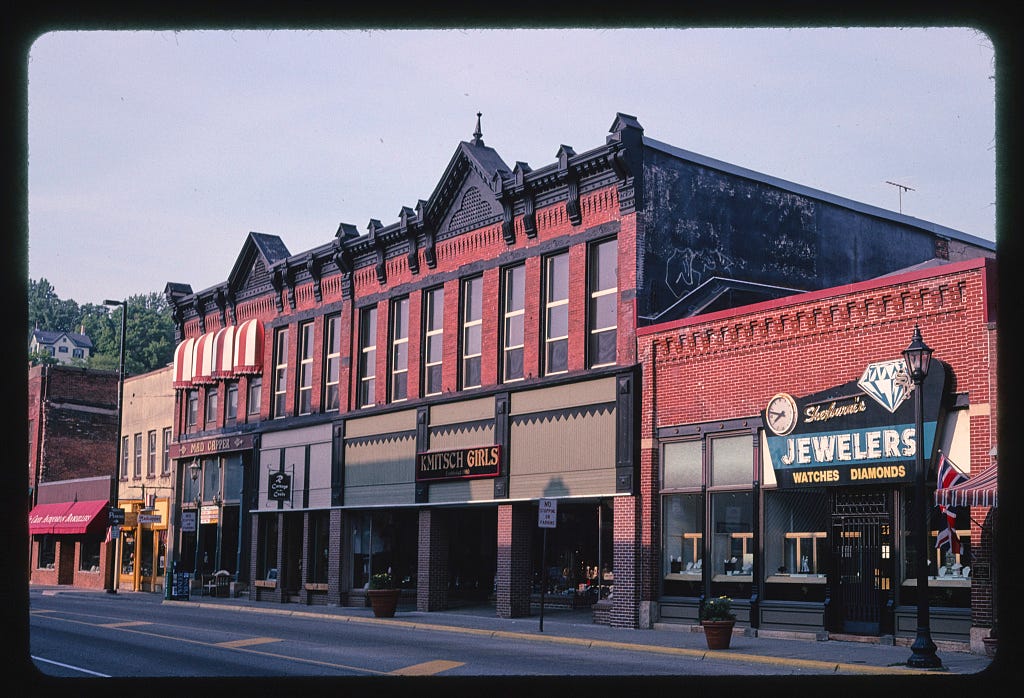The West to Who?
"Coming soon" meant 6 months, but at least it did not mean 7 months. This starts our conversation on regions in America and regions as Americana.
I thought that it would be good to get something out there that I wrote at a writing retreat last summer. So, know that when I say “Over the last two weeks” I am referring to 11 months ago. More pertinently, this article touches on one goal that I hope to talk about in Atlas Americana. Regions are tricky things, and they are never static, and never straightforward, and where they are often bickered over. We’ll talk and bicker about them a lot. This photo was taken in Stillwater, Minnesota, which saw major flooding during those two weeks.1
Over the last two weeks, much of southern Minnesota, South Dakota, and Iowa have been under water—inundated by near constant rain. With the already heavy early summer downpours being exacerbated by climate change, it has led to lakes overflowing, rivers flooding, dams bursting, and the most direct impact—homes and lives washed away. With everything in the upper Midwest between the Missouri and Mississippi rivers under threat of continued rains in the coming days, the region is soaked.
My mind initially thought about how the area’s relatively flat terrain in combination with extensive agricultural development and the impermeable built environment has essentially led to a tub that can overflow, as opposed to the natural sponge that is the Great Plains. But a thought that came sometime after, was how can this place be a part of the American West (and the Midwest) when the West, is a place known for its relative aridity (the Pacific Northwest Withstanding). How can this paradox exist?
The short answer is that the American West is honestly hard to define. This is partially due to the West’s relation to the frontier and frontier-line in American history, a constantly moving, eclipsing, and expanding target. Though there should be a distinction that frontier is process and not place, to Frederick Jackson Turner’s disappointment.2 Yet, untethered from the frontier-line, the West is still as big as ever.
If you squint, the Twin Cities and Denver Metropolitan Areas are approximately equivalent in size, at 3.7 and 3 million people respectively. These two cities each bookmark their respective ends of the Great Plains, each thriving off their respective rivers, the Mississippi and the South Platte, which feeds into the Missouri. Minnesota finds itself wearing multiple hats: Great Plains, Great Lakes, Midwest, whereas Denver holds itself firmly in the West, the gateway to the flatirons, and beyond that the rest of the Rockies. How can this be?
We must also reckon with contemporary understandings of where the West is. Since the supposed formal closure of the American frontier by the U.S. Census Bureau in 1890, the regions have settled into their conventional places, the Midwest from North Dakota to Ohio, the West from Montana downward and westward, and Texas and Oklahoma relegated to the South (perhaps on account of their Confederate association). The problem with these regions is that they are artificial, created by the Census Bureau to better enable their administrative work, data collection and analysis. Our modern day “official” regions also disturb geographic spaces such as the Great Plains, a place firmly situated in the history of the West.
While understanding where the West is will not stop the rain, it can help to change what we see. Understanding that the West is not marked by the lack of water, and instead by something else, might help us better understand how to manage water. For historians, it might help us understand deeper questions surrounding the West as more than meeting place or place of conquest.
While I have no firm answer to say, with this paradoxical situation, the answer itself must be just as paradoxical. And I ask: where is the West to who? Where do we stand?
Margolies, John, photographer. Main Street, Stillwater, Minnesota. Minnesota Stillwater United States, 2003. Photograph. https://www.loc.gov/item/2017702799/.
Patricia Nelson Limerick, The Legacy of Conquest: The Unbroken Past of the American West (New York: W. W. Norton & Co., 2006).

